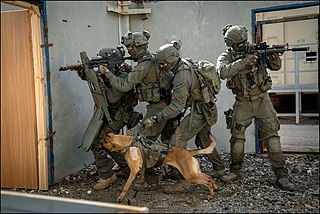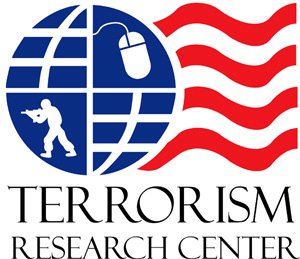
Counterterrorism, also known as anti-terrorism, incorporates the practice, military tactics, techniques, and strategy that governments, military, law enforcement, business, and intelligence agencies use to combat or eliminate terrorism. Counter-terrorism strategy is a government's motivation to use the instruments of national power to neutralize and conquer terrorists, these organizations they have, and these networks they contain in order to render them incapable of using evil to instill fear and to coerce the government or citizens to react in accordance with these terrorists' goals.
Deception or falsehood is an act or statement that misleads, hides the truth, or promotes a belief, concept, or idea that is not true. It is often done for personal gain or advantage. Deception can involve dissimulation, propaganda and sleight of hand as well as distraction, camouflage or concealment. There is also self-deception, as in bad faith. It can also be called, with varying subjective implications, beguilement, deceit, bluff, mystification, ruse, or subterfuge.
The Critical Incident Response Group (CIRG) is a division of the Criminal, Cyber, Response, and Services Branch of the United States Federal Bureau of Investigation. CIRG enables the FBI to rapidly respond to, and effectively manage, special crisis incidents in the United States.

The Terrorism Research Center (TRC) is non-profit think tank focused on investigating and researching global terrorism issues through multi-disciplinary collaboration amongst a group of international experts.
Russian military deception, sometimes known as maskirovka, is a military doctrine developed from the start of the 20th century. The doctrine covers a broad range of measures for military deception, from camouflage to denial and deception.

Aggressive mimicry is a form of mimicry in which predators, parasites, or parasitoids share similar signals, using a harmless model, allowing them to avoid being correctly identified by their prey or host. Zoologists have repeatedly compared this strategy to a wolf in sheep's clothing. In its broadest sense, aggressive mimicry could include various types of exploitation, as when an orchid exploits a male insect by mimicking a sexually receptive female, but will here be restricted to forms of exploitation involving feeding. An alternative term Peckhamian mimicry has been suggested, but is seldom used. For example, indigenous Australians who dress up as and imitate kangaroos when hunting would not be considered aggressive mimics, nor would a human angler, though they are undoubtedly practising self-decoration camouflage. Treated separately is molecular mimicry, which shares some similarity; for instance a virus may mimic the molecular properties of its host, allowing it access to its cells.
Military swarming is a battlefield tactic designed to maximize target saturation, and thereby overwhelm or saturate the defences of the principal target or objective. On the other-hand, defenders can overcome attempts at swarming, by launching counter-swarming measures that are designed to neutralize or otherwise repel such attacks.

Military psychology is a specialization within psychology that applies psychological science to promote the readiness of military members, organizations, and operations. Military psychologists provide support to the military in many ways, including through direct clinical care, consultation to military commanders, teaching others and supporting military training, and through research relevant to military operations and personnel. The stressors associated with military service are many including exposure to high-risk training and combat. As such, psychologists are critical support components that assist military leaders in designing appropriate training programs, providing oversight to those programs, and assisting military members as they navigate the challenges of military training and their new lifestyle. Most issues facing military members are not that dissimilar from those faced by their civilian counterparts. Specific examples that may be somewhat distinct include posttraumatic stress disorder (PTSD) associated with combat, or guilt and family/partner difficulties accompanying extended or frequent deployments due to separation. Clinical providers in military psychology are often focused on the treatment of stress, fatigue, and other personal readiness issues.
Information Operations is a category of direct and indirect support operations for the United States Military. By definition in Joint Publication 3-13, "IO are described as the integrated employment of electronic warfare (EW), computer network operations (CNO), psychological operations (PSYOP), military deception (MILDEC), and operations security (OPSEC), in concert with specified supporting and related capabilities, to influence, disrupt, corrupt or usurp adversarial human and automated decision making while protecting our own." Information Operations (IO) are actions taken to affect adversary information and information systems while defending one's own information and information systems.
A surgically implanted improvised explosive device (SIIED) is an explosive device hidden inside the body of a person in order to commit a suicide attack. This type of terrorist weapon, more commonly known as Body Cavity Bomb (BCB), is only known to have been used once, in a failed assassination attempt.
Deception in animals is the transmission of misinformation by one animal to another, of the same or different species, in a way that propagates beliefs that are not true.
Tactics, Techniques, and Procedures (TTPs) is an essential concept in terrorism and cyber security studies. The role of TTPs in terrorism analysis is to identify individual patterns of behavior of a particular terrorist activity, or a particular terrorist organisation, and to examine and categorize more general tactics and weapons used by a particular terrorist activity, or a particular terrorist organisation.
Interposing Tactics is tactical concept, developed under Terrorist Tactics, Techniques, and Procedures, to explain a tactical action where a small-scale action takes place between two combatants, where one manoeuvres into interposition or interjection within a tactical situation, and disrupts the action or activity, of the opponent.

A rhizome manoeuvre is a surprise attack in a built environment, made from an unexpected direction, such as through a wall or floor. It is a key concept in contemporary warfare tactics, techniques, and procedures.
Three-Dimensional (3D) Tactics Analysis, is a tactical analysis methodology under the concept of Terrorist Tactics, Techniques, and Procedures, and is related to Rhizome Manoeuvre. The approach is applicable to urban combat, and takes into account mass gatherings of people located in highly complex urban structures, incorporating features such as multi-level buildings, open spaces between buildings, crowd congregation points, and transport hubs.
Command and influence is a component of Military C2 and is a key aspect of Terrorist Tactics, Techniques, and Procedures.
Dynamic defence, is a key concept in Rhizome Manoeuvre, and Three-Dimensional (3D) Tactics Analysis, and is a key concept in contemporary Terrorist Tactics, Techniques, and Procedures.
The Fifth Dimension of Warfare complements the four classical dimensions: land, sea, air, and space. It was enunciated in 1995 as information operations.
CyberHumint refers to the set of skills used by hackers, within Cyberspace, in order to obtain private information while attacking the human factor, using various psychological deceptions. CyberHumint includes the use of traditional human espionage methodologies, such as agent recruitment, information gathering through deception, traditionally known as Humint, combined with deception technologies known as Social engineering.




